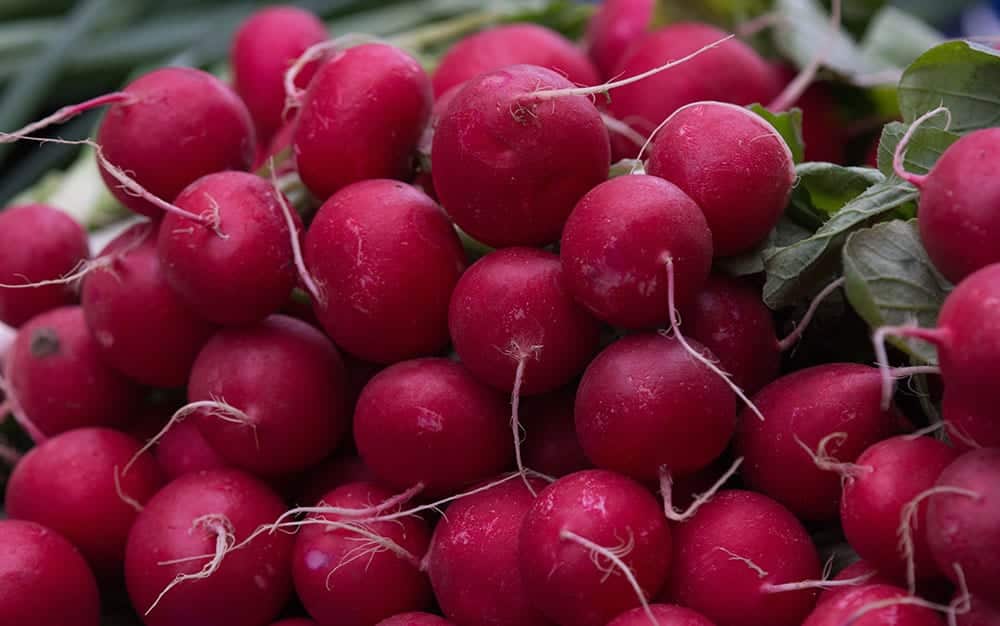There’s nothing like the sharp and crunchy bite of a radish to add some zing to your salad. Originally from Southeast Asia, radishes have been gracing our tables in the west since Pre-Roman times, and they have become a staple of British salads.
Radishes are wonderful, easy-to-grow additions to our home veg patches or allotments, but many of us only know the little pink spring varieties we usually find in the supermarket. Spring radishes are of the ‘live fast, die young’ philosophy, shooting up and ready to crop in just 3 or 4 weeks. Their fast-burning spirit means that they must be picked before they over-ripen, else they turn bitter, and they will only keep for a week or so in the fridge.


If you haven’t tried them before, I’d like to introduce you to their more mature and reserved cousin, the winter radish. They take a leisurely 8 to 10 weeks to ripen, and can stay in the ground getting larger and juicer as long as you like, so long as you harvest them before the ground freezes. They will then last for months in a refrigerator or cold room. So if you are thinking of growing radishes, think about going winter.
Though they are still lovely sliced or grated into salads, winter radishes are generally much larger, milder and sturdier than spring varieties. Spring radishes are too delicate to cook, but winter radishes are marvellous for soups, stews and stir fries.
The leaves and shoots are also delicious and not to be wasted! These peppery leaves make superb additions to salads and sandwiches, but they are also great for cooking into soups, stir fries, dal, or even for making fresh pesto with.
Nutritional Benefits
Radishes are a good source of vitamin C; providing about 25% of DRI of vitamin C per 100g. They are also a very good source of anti-oxidants, electrolytes, minerals, vitamins and dietary fibre, and they are good for digestion and relieving indigestion.
Winter Radish Varieties To Try

Daikon Radish
Long, thick and white, and their mild flavour makes them a superb salad addition, but they’re also lovely thrown into a stew. Also known as “Japanese Mooli”.

Watermelon Radish
Adds incredible colour to a dish with its bright pink centre. It’s great in fish dishes, and cooking it will enhance its sweetness. It also pairs beautifully with feta cheese and apple.

Spanish Black Radish
A large, round variety that have a hot flavour. They are great in salads and stir-fries, but also lovely just with a wedge of cheddar cheese and a rich, dark beer.
Tip
If some of your winter radishes bolt before you have a chance to harvest them, leave a few to develop seedpods. The seedpods, which look like pea pods, are actually quite tasty in a salad!
Getting Started
Start planting from mid-June through to early September, and find a spot where your radishes can get at least 6 hours of sunlight per day.
You’ll want a deep and fertile bed of soil, a good 2 feet (60cm) if you can, with plenty of well-rotted manure or compost dug in. Rake out any stones and bash any lumps of soil down with your rake handle.

Next, water the soil at this point so that you don’t need to risk displacing the tiny seeds by watering afterwards. Your furrow should be about an inch (2-3cm) deep, and the seeds, which are quite fiddly, a few inches apart. If planting multiple rows, give them about 3 to 6 inches (7-15cm) of space between rows. Rake the soil back over.
If you get a rare British winter drought, water every few days. Radishes that don’t get enough water grow slowly and turn woody.
Harvesting
Once they are ripe, winter radishes are best left in the ground. The first frosts shouldn’t hurt them, so long as you harvest them before the soil really freezes. Once out, they can stay in your fridge or a cold room for months at a time, but to keep them firm you may want to remove the greens and keep the roots in plastic bag.
Tip
The hotter the weather, the hotter your radishes will be, and the cooler the weather, the milder the taste.

Leave A Comment